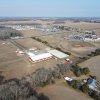Sussex Council plans stricter controls on storm runoff
A March 25 meeting with Sussex Conservation District officials raised concerns among Sussex County Council members about threats that silt from construction projects can pose to waterways and wetlands.
The discussion was held at midday during a recess of the council’s regular meeting. The gathering was noted on the council’s meeting agenda but not posted as a separate meeting open to the public.
“[Stormwater runoff is] a major concern for us in the district,” said Sussex Conservation District Coordinator David Baird March 27. “That is a priority for us.”
Sediment washed from construction sites can fill in waterways, drown out grasses and deposit nitrogen and phosphorus, Baird said.
“It can destroy or significantly impair habitats,” he said, adding he was glad to see council also making a priority of reducing runoff from construction sites.
Council’s questions at its public meeting later that day during a public hearing on a proposed housing development indicated a tougher position on the issue had arrived.
Hearings involved a zoning change and conditional-use request for the Creekside cluster development comprising 116 mixed residential units on Banks Road in Long Neck.
Council questioned developer Rudder Road LLC’s lawyer, David Hutt, about the adequacy of a forested buffer along Guinea Creek, ranging from 75 to 130 feet wide, wider than required by county law. There are also nontidal wetlands and tidal wetlands. The rest of the 30.5-acre site was clearcut in 2021 and vegetation has begun to grow.
“The cheapest, quickest easiest way [for builders has become] to clear-cut every tree, take all the stumps out, totally denude the land and then bring in the bulldozers,” said Councilman John Rieley. “If you’re sitting next to a creek, that’s a recipe for putting dirt in the water.”
Rieley said other methods better protect wildlife, wetlands and bodies of water from harm.
“Through both the Sussex Conservation District and its regulations that it now has as well as the county’s resource buffer, that practice won’t exist on this site,” Hutt said.
“No one wants to see any silt or sediment reach Guinea Creek,” he said. “Certainly everyone has a common goal there.”
The project will be designed to divert stormwater into ponds on the property, where it is treated before being released, Hutt said.
He said other projects cited by Rieley preceded a county buffer ordinance enacted in fall 2022 that require developers to address the type of concerns raised by Rieley.
Rieley said conservation district officials told council they are limited in dealing with the issue.
The project would comply with all requirements for silt and super silt fencing and buffers from wetlands and bodies of water, Hutt said.
“I’m not sure the requirements are quite high enough,” Rieley said.
“We were at the soil and water conservation district meeting this morning and this was a big topic,” said Councilman Matt Lloyd. “What’s happening is, when it rains, all that erosion ends up defeating a silt fence. It goes past. It turbulates the water and a lot of the sand ends up in the river and affects wildlife and things. We’re actively seeking ways to mitigate that.”
“I don’t feel comfortable approving projects that have some strong potential to flush significant amounts of silt into waterways,” Rieley said.
“You’re suggesting that a 100-foot buffer should be sufficient to ensure that you’re not going to flush any sediment into the creek. Is that what you’re saying?” Rieley asked.
“Correct,” Hutt responded. “And that’s why the county adopted those standards.”
Rieley asked about phasing construction to limit the amount of land that is left cleared and vulnerable to erosion.
Lloyd said council will look to add conditions to the Creekside project to ensure that nearby bodies of water are protected, and the body intends to tighten regulations.
Limiting the county’s booming development’s effect on infrastructure, schools, emergency services and healthcare has become increasingly contentious. The first meeting of a land-use reform working group, which is tasked with reviewing and recommending changes to development laws, was held March 27.
“We are not sure that the current code is going to mitigate this concern,” Lloyd said March 25. “It’s been a very hot topic that all of us are dealing with on the part of the public. Admittedly, I don’t know if it's from preexisting projects that have been approved before the buffer ordinance was changed or after.”
“I think while we look at reviewing and updating something like that, just so you know, there’s probably going to be some consideration for extra conditions to mitigate this thing that is a very hot topic right now,” Lloyd told Hutt.
Council delayed its decisions on the Creekside applications until a future meeting.
Kevin Conlon came to the Cape Gazette with nearly 40 years of newspaper experience since graduating from St. Bonaventure University in New York with a bachelor's degree in mass communication. He reports on Sussex County government and other assignments as needed.
His career spans working as a reporter and editor at daily newspapers in upstate New York, including The Daily Gazette in Schenectady. He comes to the Cape Gazette from the Cortland Standard, where he was an editor for more than 25 years, and in recent years also contributed as a columnist and opinion page writer. He and his staff won regional and state writing awards.
Conlon was relocating to Lewes when he came across an advertisement for a reporter job at the Cape Gazette, and the decision to pursue it paid off. His new position gives him an opportunity to stay in a career that he loves, covering local news for an independently owned newspaper.
Conlon is the father of seven children and grandfather to two young boys. In his spare time, he trains for and competes in triathlons and other races. Now settling into the Cape Region, he is searching out hilly trails and roads with wide shoulders. He is a fan of St. Bonaventure sports, especially rugby and basketball, as well as following the Mets, Steelers and Celtics.























































